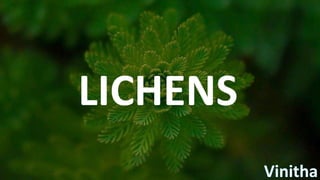
Lichens
- 1. LICHENS
- 2. General Characters of Lichen What are Lichens? • Lichen: Structurally organized permanent symbiotic association of algae and fungi. • Lichenology: Branch of biology deals with the study of lichen • Mycobiont: Fungal component of lichen • Phycobiont: Algal component of lichen
- 3. • Symbiosis: Association/interaction organisms where both partners are mutually benefitted (D-Bary) • Fungus protects algae from unfavorable conditions (drought) • Algae in turn supplies organic food to fungus • This type of symbiosis is called heliotism (master and slave relationship) • Fungal component (approximately 90%) is prominent in lichen than algal component
- 4. • Plant body of lichen neither resembles algal or fungal morphology • Theophrastus, first used the term lichen to denote superficial growth on tree barks. • Acharius: Father of lichenology • Growth of lichen is very slow • Lichen produces specific acid called lichen acid.
- 5. • Distribution: World wide distribution; 500 genera and 13500 species. • Lichens do not grow near smoky polluted industrial area • Thus, lichens are indicators of pollution (Lobaria) • They can tolerate extreme heat and can bury in snow for long years. • Habitat: Mostly on tree barks, decaying woods nad rocks. Saxicolous: Lichen growing on stones Corticolous: Lichen growing on tree barks Follicolous: Lichens growing on leaves Terricolous: Lichens growing on soil surface • Few species of lichens are aquatic (Peltigera -marine)
- 6. • Lichens are highly pigmented and have various colours due to the pigmentation of algal component. • Composition of plant body • The part of lichen, not involved in reproduction is called thallus. • The thallus is mainly composed of; 1. Upper cortex: Protective skin of densely packed fungal filaments. 2. Algal zone: These are often enclosing algae within the fungal layer. 3. Medulla: Central, main part and have conducting cells 4. Lower cortex: It is a narrow layer of compactly arranged hyphae.
- 7. Composition of plant body
- 8. Classification of Lichens • According to International Code of Botanical Nomenclature (ICBN) name of lichen should be on the basis of fungal component. • Hence, lichens are divided into; 1. Asco-Lichen: Mycobiont belongs to Ascomycotina, Reproduction similar to Ascomycotina, produce Ascus and Ascospores. Majority falls under this category 2. Basidio-Lichen: Mycobiont belongs to Basidiomycotina, produce basidia nad basidiospores during reproduction. Only few belongs to this category 3. Lichen-imperfectii: Fungal partner is Deuteromycetes. Lack sexual reproduction
- 9. Classification based on thallus morphology 3 types: 1. Crustose (Crustaceous) Lichen 2. Foliose Lichen 3. Fruticose Lichen
- 10. 1. Crustose Lichen • They have flattened thallus • Closely attached to substratum as crusts (rocks, soil or bark) • Thallus may be partially or completely embedded in the substratum • Thallus is vey closely attached to the substratum. • Example: Graphis, Lecanora, Lecidia
- 11. 2. Foliose Lichen • They have a flat dorsi-vental, leaf lobed thallus • They look like the thallus of liverworts • Attached to substratum by rhizoid like structures called Rhizines • Example: Parmelia, Pelitigera, Collema
- 12. 3. Fruticose Lichen • Well developed shrub like, cylindrical and branched thallus • They grow or hang from the substratum • Plant attached to the substratum with the help of mucilaginous disc • Example: Cladonia, Usnea
- 13. Lichen Reproduction • Vegetative Reproduction occurs by different methods: 1. Fragmentation • Most effective way • Found in foliose and fruticose lichens • Mechanical stress or death of some cells breaks the thallus into fragments. • Each fragment has growing areas • They grow into new thalli 2. Isidia • Small papilla like outgrowth • Present in upper surface of thallus
- 14. • Each isidium is composed of algal cells and fungal hyphae. • Isidia detach from the body and germinate to form new thalli. • Example: Parmelia 3. Soredia • Small bud like outgrowths formed on the surface of thallus. • Composed of many algal cells with few fungal hyphae. 4. Cephalodia • External or internal gall like outgrowths • Dark green in colour • Consists of fungal hyphae enclosed in algal cells.
- 15. Lichen Reproduction • By asexual and sexual methods • Asexual reproduction by various types of spores (Oidia, Picnidia) • Sexual Reproduction: Only fungal component reproduce sexually • Female sex organ is called carpogonium. • Carpogonium is differentiated into basal ascogonium and an elongated trichogyne. • Male reproductive organ is spermagonia which produces spermatia
- 16. Economic importance of Lichens • They grow on rocks and release some chemicals that can disintegrate rocks and this results in rock weathering. Hence, they help in soil formation. • They are used as a source of food. For example, Parmelia. Its species are used as curry powder in India. • They are used as a source of medicines. For example, usnic acid which is obtained from Usnea, is an antibiotic used in the treatment of various infections and Cladonia (Reindeer moss) is used in the treatment of whooping cough.
- 17. • Some lichens such as Pseudorina and Evernia are used in the production of perfume and essential oils. • Litmus which is a dye used as an indicator of acid and base, is obtained from lichens Roccella tinctoria and Lasallia pustulata.
- 18. Harmful Aspects: • Lichens growing on young fruit trees and sandal trees are harmful to the plant. • During hot season some species of lichens (e.g., Usnea barbarata) become so dry and inflammable that they often help in spreading forest fire. • Some lichens act as allergens. • The commercial value of glass and marble stone is reduced because of itching of their surface by lichens. • Some lichens e.g., Cladonia rangifera, Cetraria islandica accumulate large quantities of radioactive strontium (Sr90 ) and caesium (Cs137 ) from atomic fall-outs. These may be incorporated in the food chain, lichen → reindeer → man, leading to their accumulation in human tissues.
- 19. THANK YOU